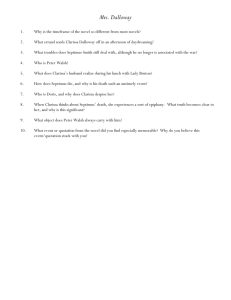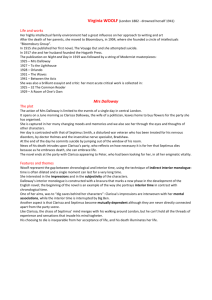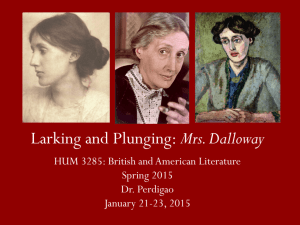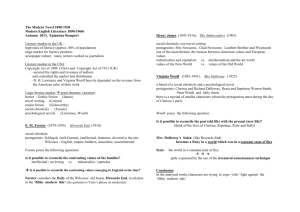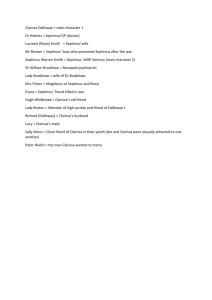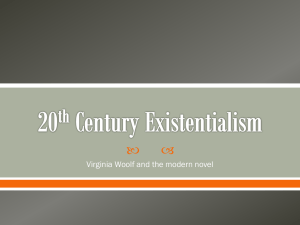Outline and Bibliography - This site is under development
advertisement
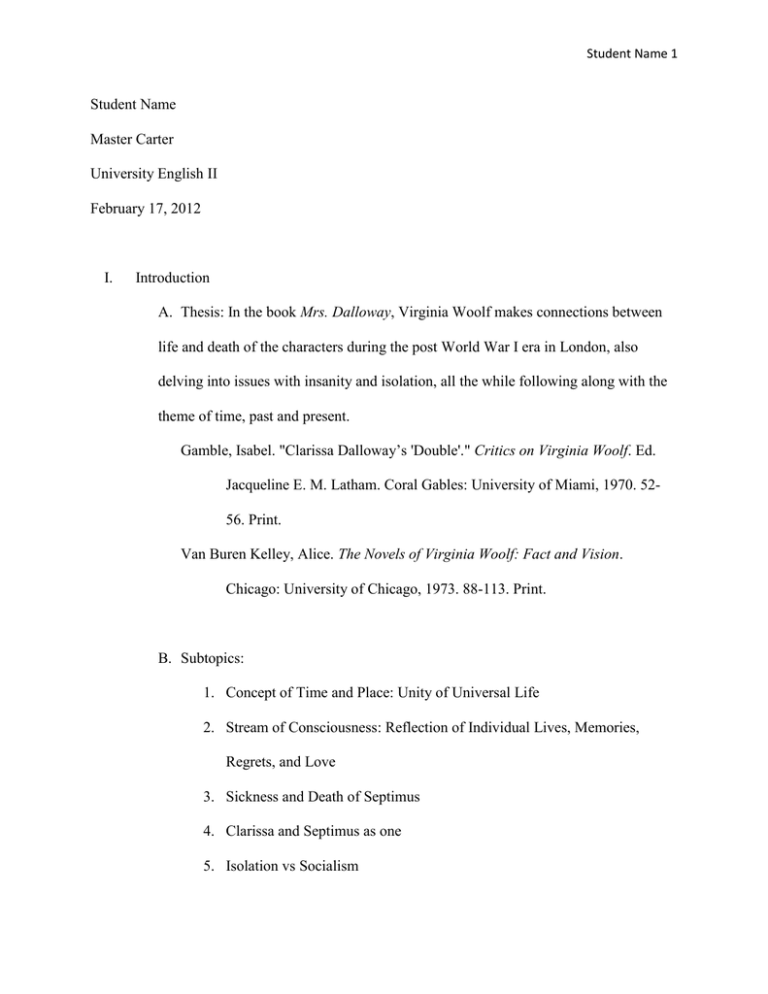
Student Name 1 Student Name Master Carter University English II February 17, 2012 I. Introduction A. Thesis: In the book Mrs. Dalloway, Virginia Woolf makes connections between life and death of the characters during the post World War I era in London, also delving into issues with insanity and isolation, all the while following along with the theme of time, past and present. Gamble, Isabel. "Clarissa Dalloway’s 'Double'." Critics on Virginia Woolf. Ed. Jacqueline E. M. Latham. Coral Gables: University of Miami, 1970. 5256. Print. Van Buren Kelley, Alice. The Novels of Virginia Woolf: Fact and Vision. Chicago: University of Chicago, 1973. 88-113. Print. B. Subtopics: 1. Concept of Time and Place: Unity of Universal Life 2. Stream of Consciousness: Reflection of Individual Lives, Memories, Regrets, and Love 3. Sickness and Death of Septimus 4. Clarissa and Septimus as one 5. Isolation vs Socialism Student Name 2 C. Type of Grabber/Hook: 1. Vivid descriptions of scenery 2. A look into the lives and thoughts of the sane and insane, and the ideas of death within each II. Development of Subtopics A. Subtopic 1: The book takes place over the course of one day, during which time is emphasized by the constant reminder of hours passing by the clock tower. The concepts of time and place bring about the theme of universal life, establishing connections among the characters. Graham, John. "Time in the Novels of Virginia Woolf."Critics on Virginia Woolf. Ed. Jacqueline E. M. Latham. 8th ed. Coral Gables: University of Miami, 1970. 2830. Print. B. Subtopic 2: Clarissa looks back on her proposal from Peter and her feelings for Sally and wonders if she made the right life decision with marrying Richard. Johnson, Manly. Virginia Woolf. New York: Frederick Ungar, 1975. 54-55. Print. C. Subtopic 3: Septimus suffers from shell shock and is considered “mad” by his doctors because of his detachment from his feelings and of the things of life. Toward the end of the novel, he is driven to the final point of insanity and jumps out of a window. Johnson, Manly. Virginia Woolf. New York: Frederick Ungar, 1975. 58-63. Print. Student Name 3 D. Subtopic 4: Clarissa begins to view the death of Septimus with relief. She believes that the “unseen part” of his life may be now carried out through her life. Van Buren Kelley, Alice. The Novels of Virginia Woolf: Fact and Vision. Chicago: University of Chicago, 1973. 88-113. Print. E. Subtopic 5: Woolf displays the contrast between socializing and isolating oneself with the party held by Clarissa, the death of Septimus, and the solitary woman in the window across from the party. Van Buren Kelley, Alice. The Novels of Virginia Woolf: Fact and Vision. Chicago: University of Chicago, 1973. 108-113. Print. III. Conclusion: A. Summary: In the book Mrs. Dalloway, characters are connected through memories, relationships, and some through the concept of death. While depicting the social classes of post World War I Society, Woolf also contrasts insanity with sanity and also compares this social lifestyle with that of isolationism. B. Logical Conclusion: Insanity is to be separated from things, people, and all other things of the world, so in a way, it may be compared to death, which in the end everyone must face, and when one dies, the unseen part of their self which survives may be carried out through another and so on. Student Name 4 Student Name Master Carter University English II 19 March 2012 Mrs. Dalloway: The Unity of Life Universal Mrs. Dalloway by Virginia Woolf is a novel set in the post World War II era in London entailing one day in the life of Clarissa Dalloway, from her nostalgic walk through the streets of London to her many encounters with various acquaintances and finally to her execution of the party she had previously planned for that evening. While the story is mainly focused on Clarissa, the points of view tend to shift from character to character, revealing their inner thoughts and using a spectrum of perspectives to put together a more extensive review of her life. In the book Mrs. Dalloway, Woolf makes connections between life and death of the characters through their stream of consciousness, also delving into issues with insanity and isolation, all the while following along with the theme of time, past and present. Woolf paints a picture of universal life with her vivid descriptions of scenes through the eyes of various characters throughout the day. The same places and events are seen by multiple characters though they have no connection with each other. For example, when the airplane with the intent of advertising Toffee began spelling letters in the sky, it was observed by “…all people in the Mall, in the Green Park, in Piccadilly, in Regent Street, and in Regent’s Park…” +1(Woolf 30). From Clarissa and her acquaintances Mrs. Coates, Mrs. Bletchley, and Mr. Bowley, who all had different interpretations of the letters, to Lucrezia and Septimus, who believed in his “mad” state of mind that he was being signaled to, the fact that every person in all of these places, each other with their own each individual lives, agendas, and perspectives, witnessed this same exact Student Name 5 event, creates a sort of unity. However, the element of scene depiction is also used numerous times to help lay out a kind of map in the mind of the reader in which they can imagine the paths of individual characters, sometimes crossing, but essentially isolated. Each character moves from one location to another, sometimes even to the same locations at different times and to different locations at the same time. Though maintaining the sense of unity, there is also the essence of separation between the characters, as they each have their individual self. The same unity as brought about by shared witnessing of the same events is also brought about with another theme throughout the book: time. The concept of time and place in Mrs. Dalloway may also be implied by Avrom Fleishman in Virginia Woolf: A Critical Reading as “a series of ‘life junctures’”+1 (70). These “life junctures” are described by Fleishman as “a presence of certain sensory phenomena in different contexts” +1(70). They happen infinitely throughout the passing of time and are used in Mrs. Dalloway to connect the characters that otherwise have no previous knowledge of one another. Time is referenced frequently in Mrs. Dalloway, most often by the sounding of the famous London clock, Big Ben. This incessant reminder of the passing of time can be seen from the early hour of her walk to purchase flowers in the early morning: “There! Out it boomed. First a warning, musical; then the hour, irrevocable” +1(5) up until the closing moments of her party that very night: “She pulled the blind now. The clock began striking” +1(283). In Time in the Novels of Virginia Woolf, John Graham states, “people exist in the same stream of time, each moving under the compulsion of the time flow (as symbolized by Big Ben), visible to each other, yet unknown to each other and essentially alone.” (29) mla This explanation describes time as a sort of force that moves constantly, carrying with it each human being until they get closer to their inevitable death, and Clarissa certainly feels the force of time moving her along as she says, Student Name 6 “Shredding and slicing, dividing and sub-dividing, the clocks of Harley Street nibbled at the June day…” +1(154). Woolf’s concept of time seems to be that all humans exist in the same frame of time forever, though some may have existed longer or experienced more, all are stuck in the stream of flowing time until it has been decided that any one shall flow on with the others no longer. Just as Clarissa exclaimed, “...as if Big Ben were all very well with his majesty laying down the law, so solemn, so just…” +1(193), time it does not stop, and it does not slow down for anyone; universal life goes on. This matter of the cruelness of time also brings reference to the harsh fact of death, and Clarissa confronts the reality of this tragic human inevitability with negative speculation: "Did it matter then . . . that she must inevitably cease completely; all this must go on without her; did she resent it; or did it not become consoling to believe that death ended absolutely?" +1(12). Toward the end of the story, however, she has formulated her own possible belief of how when one dies, their soul or the “unseen part” of them may “survive, be recovered somehow attached to this person or that…” +1(232), bringing about the point that death actually doesn’t cease completely ones soul, but allows it to live on through the lives of those who are missing something. Even living she felt that she was “…part of people she had never met; being laid out like a mist between the people she knew best, who lifted her on their branches as she has seen the trees lift the mist, but it spread ever so far, her life, herself” +1(120). Taking this idea and applying it to reach a similar revelation about death brings about a content feeling that eventually there will be a connection between the “unseen part” of her to another living being, creating a purpose to living and a satisfaction in dying, and also reinforcing the idea Woolf is trying to convey of universal life. During her reflections on life and death, she also takes a look into her past relationships and life choices. Student Name 7 The past, a period of time which has been lived and forever remembered, is delved into quite often by Woolf’s characters. Each reveals a stream of consciousness pouring with fond memories of friends, wonders of untaken chances, and uneasiness about the future. Clarissa has a tendency to second guess her life, feeling oppressed by her decisions, such as the one to marry Richard Dalloway, a reserved man involved in his work in the government, instead of Peter Walsh, a man with who “everything had to be shared; everything gone into. And it was intolerable...” +1(10). When recollecting the relationship between herself and Peter Walsh, Clarissa contemplates her choice in denying his proposal with justification: “...they would’ve been destroyed, both of them, ruined…” +1(10). Clarissa feels this way because of the manner in which Peter is constantly criticizing her behavior and demanding to be informed of everything. He believes she is too caught up in the things of the world. However, as Peter is given his own monologues throughout the novel, it is revealed that Peter still consistently thinks about Clarissa, and even with the faults he finds within her, he seems to still be in love with her, the woman he once asked to marry. ¶Oz Another component of Clarissa’s deliberation of her decision was the relationship between herself and Sally Seton. Sally was a sort of wild friend of Clarissa in her teenage years who smoked cigars and spoke her mind. She and Clarissa once shared a kiss when they were younger, and this kiss has been a sweet memory ever since, provoking the idea that she might have loved Sally; however, Clarissa knows that she doesn’t have the option to be with her. These doubts about her life put forth the idea that she has reached a stage where she feels unsure of herself and her decisions and is searching shftT for some sort of comfort in herself, which little does she know, will later be something consummated by a man whom she will never even know the name of. Student Name 8 Septimus Smith is a character who is experiencing severe post traumatic stress from his time in the war. A friend of Septimus named Evans was killed during the war, and after feeling no emotion concerning the passing of his friend, he married a young Italian woman Lucrezia to help comfort his new found coldness, but it wasn’t long before he began to lose his connection to the world around him, falling into a mental sickness which would ultimately lead to his demise. As Manly Johnson describes insanity in Virginia Woolf as “isolation from people, from things, from all the stuff of life – death, in short” +1(62), Septimus shows obvious signs of insanity with his detachment from those around him and even himself, however, he proceeds to demonstrate a strong connection with nature. A more precise diagnosis of Septimus would be that of Alice Kelley in The Novels of Virginia Woolf: Fact and Vision: “…his sense of a definable self is missing, so that instead of coming into contact with the external world, he literally feels himself one with it.” +1(99). While in the park, there are moments when Septimus becomes unified with the natural things around him, such as when he feels, “Red flowers grew through his flesh” +1(103). Not only does he believe, “Men must not cut down trees” +1(35), but he now feels literally a part of the plants he observes: “And the leaves being connected by millions of fibres with his own body, there on the seat, fanned it up and down; when the branch stretched he, too, made that statement. The sparrows fluttering, rising, and falling in jagged fountains were part of the pattern…” +1(32-33). Just as Kelley suggested, he cannot make a connection with himself, so instead, he is forced to connect with something which is indeed living, yet also has no feelings. Septimus has not the ability to feel or sympathize, such as when Lucrezia begins to cry, and he has no sort of emotional response: “Far away he heard her sobbing… but he felt nothing” +1(136). Woolf depicts Septimus as one who is now incomplete as a human, lacking his ability to connect with other life, and therefore is declared insane. After many visits with doctors who Student Name 9 he believes are trying Tto control him, he is finally driven to the point at which he can live no longer lacking his sense of control and ability to feel, and he throws himself through a window to his death, just after reciting a line from Shakespeare’s Cymbeline, “Fear No More.”source +1 Clarissa and Septimus both repeatedly use this allusion to Shakespeare, “Fear No More the heat of the sun,” source +1 whether to bring comfort and the motivation to face life, the reason Clarissa often used the phrase, or to give the strength to end it all, the last purpose of its recital by Septimus. This phrase is just one of the many things Woolf uses to create a parallel between the two characters. The characters of Septimus has been viewed as Clarissa’s “double” by many critics, as the correlation between the two in Mrs. Dalloway is undeniable, from the similar experiences to the unknown crossing of their paths throughout the day. Woolf establishes several ties between the two; the first subtle indication would be that they are both described as having “beaked faces” (14) or being “beak-nosed” +1(20). ¶Oz Another pair of moments which correspond between the lives of them both would be the purchasing of flowers by their spouses, though these flowers had a certain distinctive difference which symbolized their situations. Richard Dalloway, while having an instance of revitalized love for his wife, picked up bouquet of red and white roses to bring home to her. Alternately, Lucrezia also brought home roses she had bought from a man in the street, yet these roses were, like Septimus in his condition, “almost dead” +1(141). ¶Oz The last of these paradigms used by Woolf to complete the intertwining of the two incomplete characters is seen when Septimus takes the climactic and fearless leap toward his death with the cry, “I’ll give it to you!” +1(226). In this scene, Woolf notes that just beforehand, an old man is seen opposite to him on the stairwell; moreover, when Clarissa hears the news of the suicide, she opens her curtains and realizes, “Oh, but how surprising!—in the room opposite the old lady stared straight at her!”+1 (283). This link between the old man’s Student Name 10 presence at Septimus’s death and Clarissa’s coinciding encounter with the old woman can be interpreted as a sort of passing on of his “unseen self” to be further lived out in her. Clarissa’s response to the death of this man she did not know was one of revitalization; there was a newly found passion for life through her acknowledgement of the profound conjunction of the two: “She felt somehow very like him – the young man who had killed himself. She felt glad that he had done it; thrown it away. The clock was striking. The leaden circles dissolved in the air. He made her feel the beauty; made her feel the fun. But she must go back. She must assemble” +1(283-284). This particular point is one which not only conclusively joins Septimus and Clarissa, but it also awakens her soul, as she absorbs the great desperation of this man to maintain control by ending his prolonged grief with a final embrace in death, and now gains the inverse: a commitment to living life. “From this standpoint, the contrast between the life-affirming Clarissa and the death-seeking Septimus may seem absolute,” states Fleishman, “but the ambiguity in Clarissa’s imagination – and her self-identification with the suicide – serves to align the two characters, even to blunt the distinction between life affirmation and death wish” +2 super proof(87). To sum up the affixation between the two, one life was lived out in another. Johnson evaluates the lives of the two characters through their inverse relations to the social aspect of society: “Clarissa moves away from isolation toward an acceptance of life in all its puzzling complexity; Septimus moves ever deeper into isolation and finally suicide” +1(52). By this comparison, it may be implied that the final push of Septimus into the most extreme form of isolation, or suicide, caused an equal and opposite reaction within Clarissa. There are ew usg consistent implications given by Woolf which suggest a theme of isolation as opposed to socialism throughout Mrs. Dalloway. Clarissa herself is a character Student Name 11 thriving off of social interactions. “The obvious thing to say of her was that she was worldly,” Peter remarks, “cared too much for rank and society and getting on in the world” +1(115) Clarissa put forth great effort to assimilate with the higher social class of this time. “They’re an offering,” source replied Clarissa when asked about her parties. She craves the social interaction, quite possibly to counter her lengthy periods of isolated deep thought, consisting of mainly self scrutinization. Irene Simon lays out the basic reasoning for her love of interaction in Some Images in Mrs Dalloway, “…the love and fear of the ever flowing life around her, the wish to be taken into it and the fear of being swallowed by it, are suggested at this early stage in the novel.”+1 source Clarissa longs to be immersed in an atmosphere where other life coexists, separately, but together, such as when she first embarks on her journey through the streets of London to retrieve flowers for her party and is immediately overwhelmed by the scenes of life around her: “In people’s eyes, in the swing, tramp, and the trudge; in the bellow and the uproar; the carriages, motor cars, omnibuses, vans, sandwich men shuffling and swinging; brass bands; barrel organs; in the triumph and the jingle and the strange high singing of some aeroplane overhead was what she loved; life..” (5). +1 She loved knowing that she was in a place encompassed by wide-spread life. There is no question that Clarissa herself is a social being; however, the fact that a party was the closing of the story is relatable also to Woolf’s theme of universal life. Alice Kelley notes, “So at the level of society, where people are limited and isolated by their factual selves, Clarissa’s party provides the uniting force…” +1(109). In fact, every person Clarissa had encountered that day, along with those whom she did not physically come in contact with, but had recollected memories of prior to the party, were all there; even the Prime Minister whom she had seen driving by and Sally Seton, whom was now married with children and she had not seen in years. Student Name 12 Contrary to the idea of surrounding oneself with life, there is the idea of isolationism, most eminently embodied by the old woman who lives across the way from Clarissa. Fleishman affirms, “She admires the woman in the window across the way as a model of her own privacy” +1(79). Of course there is another side to Clarissa, shown by her tendency to drift into deep thought when alone. When she observes the woman alone in her room, she is reminded of this side of herself, and she respects it, her sense of privacy. “It was fascinating to watch her, moving about, that old lady, crossing the room, coming to the window,” declared Clarissa, “Could she see her? It was fascinating, with people still laughing and shouting in the drawing-room, to watch that old woman, quite quietly, going to bed alone” +1(283). It is a curious thing to her, considering that there is life going on undisturbed in the room across the way. Clarissa finds it fascinating to think that while there is a party, filled with life and excitement and conversation between the many individuals occupying her home, there is a room, so close to hers that is occupied by a single woman who is not aware of the exuberance of life across the way. After the woman turns out her light, Clarissa closes the curtains and continues on with her party. This is ref comparable to death in a sense, giving off the notion that regardless of who is left in the dark, or of who is no longer living, life goes on. Johnson makes the same connection and says, “Putting out the light was like dying. It did not stop the activity of living; the pageant of life went on”+1 (59). The novel Mrs. Dalloway is one in which Woolf uses time and place and alternate perceptions of these times and places to create a motif of unity. The switching points of view allow for these adjacent streams of consciousness to come together and tell the story of the life of Clarissa Dalloway, while also letting Clarissa give her own insight to the events of her past. Clarissa contemplates past relationships, the future inevitability of death, and her present state of Student Name 13 being as affected by these factors. Beginning the novel as a woman who is unsure of her feelings toward these issues, she ultimately finds a comforting sort of purpose in life and ends the novel with a successful party, which unites the novel as a whole, connecting everything. Dealing with the death of Septimus, the isolationism of the woman across the way, the reflection of her past through Sally and Peter, and the striking of the clock, every element is brought to a central point in the end. The newfound commitment to one’s life from the absorption of another’s, the realization that life goes on infinitely in phase with the rest of existence regardless of what happens, and the idea that every person is somehow connected, all becomes pieced together to exhibit a theme of universal life. Superior development of a difficult idea: I’m proud of you. +3 Student Name 14 Works Cited Johnson, Manly. Virginia Woolf. New York: Frederick Ungar, 1973. 51-64. Print. Fleishman, Avrom. Virginia Woolf: A Critical Reading. Baltimore: Johns Hopkins University, 1975. 69-95. Print. Van Buren Kelley, Alice. The Novels of Virginia Woolf: Fact and Vision. Chicago: University of Chicago, 1973. 88-113. Print. Graham, John. "Time in the Novels of Virginia Woolf."Critics on Virginia Woolf. Ed. Jacqueline E. M. Latham. 8th ed. Coral Gables: University of Miami, 1970. 28-44. Print. Simon, Irene. "Some Images in Mrs Dalloway." Critics on Virginia Woolf. Ed. Jacqueline E. M. Latham. 8th ed. Coral Gables: University of Miami, 1970. 57-60. Print.
